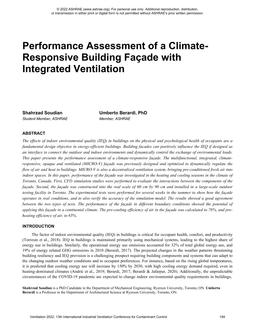
029 — Performance Assessment Of A Climate-responsive Building Façade With Integrated Ventilation
Click here to purchase
The effects of indoor environmental quality (IEQ) in buildings on the physical and psychological health of occupants are a fundamental design objective in energy-efficient buildings. Building facades can positively influence the IEQ if designed as an interface to connect the outdoor and indoor environments and dynamically control the exchange of environmental loads. This paper presents the performance assessment of a climate-responsive façade. The multifunctional, integrated, climate- responsive, opaque and ventilated (MICRO-V) façade was previously designed and optimized to dynamically regulate the flow of air and heat in buildings. MICRO-V is also a decentralized ventilation system, bringing pre-conditioned fresh air into indoor spaces. In this paper, performance of the façade was investigated in the heating and cooling seasons in the climate of Toronto, Canada. First, CFD simulation studies were performed to evaluate the interactions between the components of the façade. Second, the façade was constructed into the real scale of 60 cm by 90 cm and installed in a large-scale outdoor testing facility in Toronto. The experimental tests were performed for several weeks in the summer to show how the façade operates in real conditions, and to also verify the accuracy of the simulation model. The results showed a good agreement between the two types of tests. The performance of the façade in different boundary conditions showed the potential of applying this façade in a continental climate. The pre-cooling efficiency of air in the façade was calculated to 78%, and pre- heating efficiency of air, to 65%.
Product Details
- Published:
- 2022
- Number of Pages:
- 10
- Units of Measure:
- Dual
- File Size:
- 1 file , 1.9 MB
- Product Code(s):
- D-IIVC2022-C029
- Note:
- This product is unavailable in Russia, Belarus


